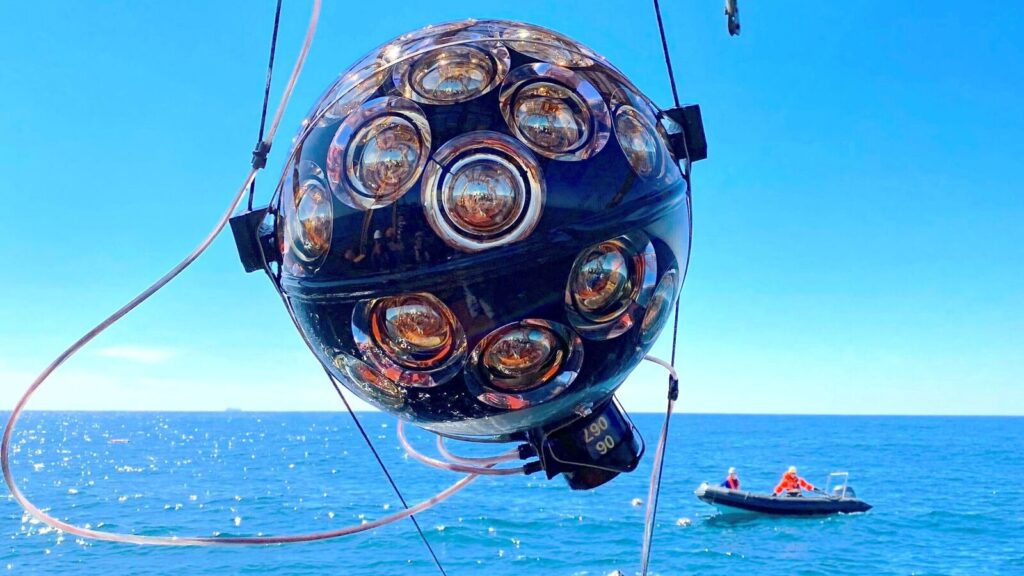On Februrary 13th 2023 an object with extraterrestrial origins went screaming through the Mediterranean Sea off the Sicilian coast. A single, super-energetic subatomic particle left a sparkling trail of light in the depths. And it did so right in the middle of an odd sort of telescope that was partway through construction. In a paper published in Nature this week, the scientists in charge of KM3Net discuss how they detected the signature of the most powerful neutrino that science has ever seen.
KM3Net is not a conventional telescope. It does not rely on visible light, as astronomers long have, nor on other bits of the electromagnetic spectrum, such as radio waves or gamma rays, that were added to their arsenal in the 20th century. Instead it examines the universe with neutrinos, ghostly but omnipresent subatomic particles that are produced in nuclear reactions. Scientists had theorised that very-high-energy neutrinos ought to exist, produced by violent astronomical processes such as gamma-ray bursts or matter falling into giant black holes. Now they have evidence that they were right.
Detecting neutrinos is difficult. They are aloof particles that rarely deign to interact with the rest of the universe. They feel only two of the four fundamental forces: the weak nuclear force, which works over very small distances, and gravity; they are immune to electromagnetism and the strong nuclear force. Trillions of neutrinos, mostly produced by the Sun, rain down on each square metre of Earth’s surface every second. The vast majority sail right through the planet.
Occasionally, though, one will slam straight into another subatomic particle inside an atom. That will produce a shower of secondary particles that are much easier to spot. A neutrino telescope, therefore, is a giant exercise in statistics. Observe lots of atoms for a long time and sooner or later you will see a collision. Detectors like Super Kamiokande, in Japan, or ICE Cube, in Antarctica, use huge quantities of ultra-pure water and ice respectively. The secondary particles produced by neutrino collisions produce characteristic flashes of light as they pass through the detector. KM3NET uses the Mediterranean Sea instead. Two groups of detectors sit several kilometres deep in the waters off Sicily and Toulon in France. (A third is planned near Pylos, in Greece.)
The neutrino from 2023 came in from the west, travelling almost horizontally. It passed through more than 100km of rock before colliding with something and generating a very energetic muon—a heavier cousin to the electrons that surround atomic nuclei. It was that muon, rather than the neutrino itself, that flashed through the detector. But by working backwards, the researchers were able to tentatively conclude that the neutrino that generated it was packing something like 220 petaelectron-volts of energy—in layman’s terms, about as much as a ping-pong ball dropped from a height of a metre.
The big question is what could have produced it. Fortunately, the neutrinos’ reluctance to interact with anything means they chart straight paths through space, unaffected by magnetic fields or clouds of gas. When KM3NET’s researchers went looking through archived observations of the patch of space from which the neutrino had come, they spotted a dozen “blazars”, jets of energy produced by matter falling into black holes, pointing straight at Earth. Any of those could have been the source.
But they are not sure: the detection was made while KM3NET was about only 10% complete, and there are other, less exciting, possible explanations. In future, scientists will be better prepared. An automated system, designed to alert other telescopes to noteworthy neutrino detections, was not working in 2023. Had it been, scientists could have quickly trained all manner of other instruments on the relevant patch of the sky, hoping to spot extra clues. That system should be up and running soon. All that can be done now is wait and hope that something similar happens again.
© 2025, The Economist Newspaper Limited. All rights reserved. From The Economist, published under licence. The original content can be found on www.economist.com

